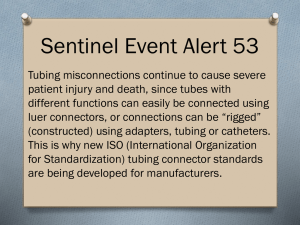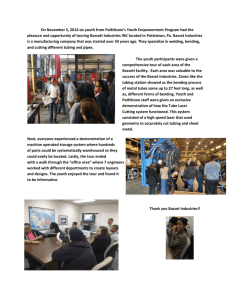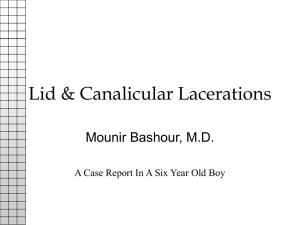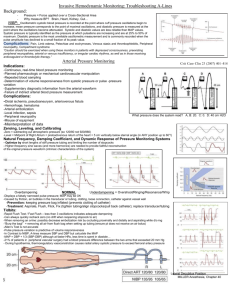Coiled Tubing Load Cells
advertisement
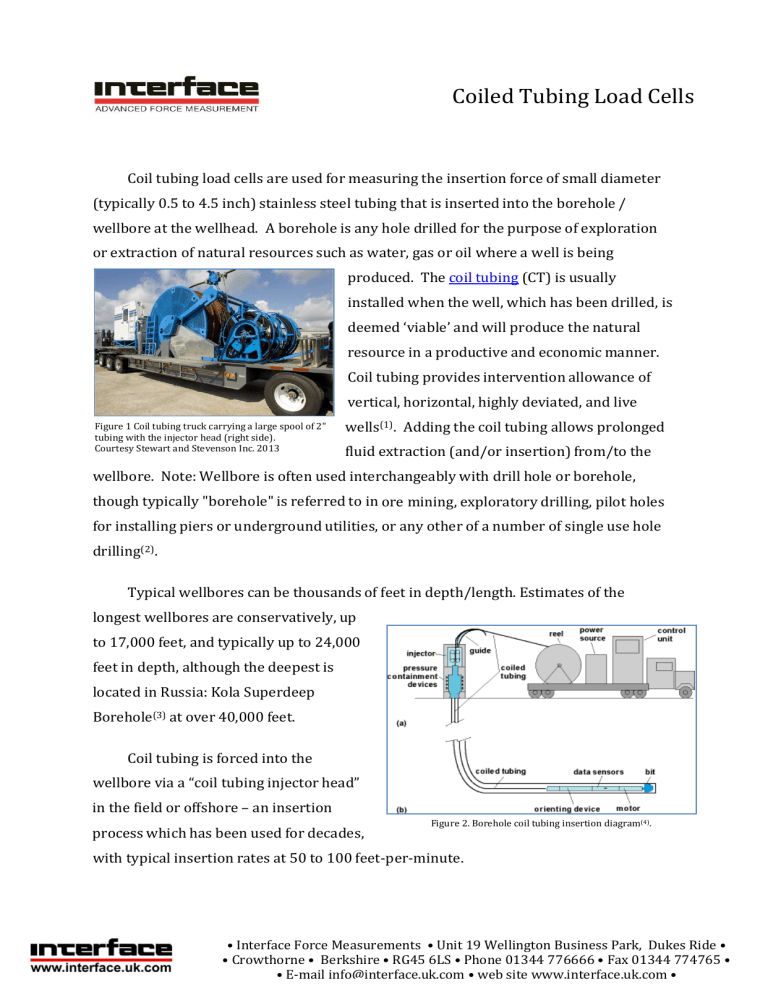
Coiled Tubing Load Cells Coil tubing load cells are used for measuring the insertion force of small diameter (typically 0.5 to 4.5 inch) stainless steel tubing that is inserted into the borehole / wellbore at the wellhead. A borehole is any hole drilled for the purpose of exploration or extraction of natural resources such as water, gas or oil where a well is being produced. The coil tubing (CT) is usually installed when the well, which has been drilled, is deemed ‘viable’ and will produce the natural resource in a productive and economic manner. Coil tubing provides intervention allowance of Figure 1 Coil tubing truck carrying a large spool of 2" tubing with the injector head (right side). Courtesy Stewart and Stevenson Inc. 2013 vertical, horizontal, highly deviated, and live wells(1). Adding the coil tubing allows prolonged fluid extraction (and/or insertion) from/to the wellbore. Note: Wellbore is often used interchangeably with drill hole or borehole, though typically "borehole" is referred to in ore mining, exploratory drilling, pilot holes for installing piers or underground utilities, or any other of a number of single use hole drilling(2). Typical wellbores can be thousands of feet in depth/length. Estimates of the longest wellbores are conservatively, up to 17,000 feet, and typically up to 24,000 feet in depth, although the deepest is located in Russia: Kola Superdeep Borehole(3) at over 40,000 feet. Coil tubing is forced into the wellbore via a “coil tubing injector head” in the field or offshore – an insertion process which has been used for decades, Figure 2. Borehole coil tubing insertion diagram(4). with typical insertion rates at 50 to 100 feet-per-minute. • Interface Force Measurements • Unit 19 Wellington Business Park, Dukes Ride • • Crowthorne • Berkshire • RG45 6LS • Phone 01344 776666 • Fax 01344 774765 • • E-mail info@interface.uk.com • web site www.interface.uk.com • Coiled tubing injectors are comprised of several key individual components ensuring that the coiled tubing is inserted correctly without damage – the load cell is the heart of the system, which provides “force measurement feedback” to ensure that the tubing does not collapse, crumple, or crimp when being inserted in wellbore or borehole (see Figure 2). Should the tubing fail (buckle, etc.) during insertion, it creates a condition called CT "lock up". When this occurs, the coil tubing process must be aborted, which is a costly and timeconsuming mistake. To minimize any chance of this failure occurring, coil tubing load cells are used to measure, monitor, and control forces applied to the tubing. Figure 3. Interface's model 3400 coil tubing load cell - specifically designed for CT applications Adding the CT liner to the wellbore/bore hole allows engineers / miners /riggers to readily access the depth of the well for stimulation and intervention. Whether one is extracting fluid from the well, or inserting fluids in to the well, CT is a proven and commercially viable tool that is used, primarily, to improve the efficiency of a well. Typical tubing diameters are from 1.25" to 3". The wall thickness and diameter is determined by the depth and direction of the well. Horizontal wells often require “stiffer” tubing due to extraneous forces applied during insertion. Coiled tubing is an industry solution and commercial tool that continues to meet higher economic ROI demands. The concept is simple – feed a continuous length of steel tubing into a wellbore, then use that access to insert anything from fluids to specialized tools to stimulate production(4); whether land based or offshore. The advantage of utilizing coiled tubing over jointed tubing is the ability to work on a live well without first killing production. Coiled tubing operations also offer increased speeds in delivering / extracting materials/fluids with fewer personnel – the rigidity of coiled tubing allowing it to be pushed into the wellbore, even in horizontal drilling applications creates a most versatile solution in today’s modern well operations and services – including but not limited to drilling, logging, cleanouts, fracturing, cementing, under-reaming, fishing, completion and production(5). • Interface Force Measurements • Unit 19 Wellington Business Park, Dukes Ride • • Crowthorne • Berkshire • RG45 6LS • Phone 01344 776666 • Fax 01344 774765 • • E-mail info@interface.uk.com • web site www.interface.uk.com • Since 1968, Interface has been making world class low profile load cells. Interface has applied that expertise in creating our model 3400 family of coil tubing load cells. The 3400 has endured the rigors of the tough oilfield environment for nearly 15 years. This product available in capacities from 20K up to 300Klbf and incorporates a stainless steel, hermetic design to IP68. Also included is an intrinsically safe, 4-20mA output. This product family has been approved for use in hazardous environments by ATEX, CSA as well as Factory Mutual (FM). For a complete listing of coil tubing (CT) terms and glossary see this edition of ReelReporter(6)newletter. 1. 2. 3. 4. 5. 6. http://www.ICoTa.com – “An Introduction to Coiled Tubing: History, Application, and Benefits”, Presentation; International Coiled Tubing Association 2005 http://en.wikipedia.org/wiki/Wellbore http://en.wikipedia.org/wiki/Borehole http://www.nov.com/Well_Service_and_Completion/Coiled_Tubing_Equipment.aspx http://www.gomcmag.com/online_exclusives/2013/01/coiled_tubing_continues_to_expand_its_reso urce_industry_reach http://ctes/nov..com/documentation/papersarticles/ICoTARR83.pdf • Interface Force Measurements • Unit 19 Wellington Business Park, Dukes Ride • • Crowthorne • Berkshire • RG45 6LS • Phone 01344 776666 • Fax 01344 774765 • • E-mail info@interface.uk.com • web site www.interface.uk.com •


